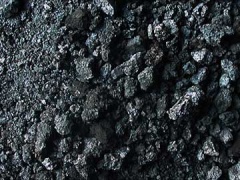Petrol Coke
| Infobox on Petrol Coke | |
|---|---|
| Example of Petrol Coke |  |
| Facts | |
| Origin | - |
| Stowage factor (in m3/t) | 1,46 m3/t (bulk) |
| Humidity / moisture | - |
| Ventilation | No special requirements |
| Risk factors | See text |
Petrol Coke
Description
Petroleum coke (often abbreviated Pet coke or petcoke) is a carbonaceous solid derived from oil refinery coker units or other cracking processes. Other coke has traditionally been derived from coal.
This coke can either be fuel grade (high in sulphur and metals) or anode grade (low in sulphur and metals). The raw coke directly out of the coker is often referred to as green coke. In this context, "green" means unprocessed. The further processing of green coke by calcining in a rotary kiln removes residual volatile hydrocarbons from the coke. The calcined petroleum coke can be further processed in an anode baking oven in order to produce anode coke of the desired shape and physical properties. The anodes are mainly used in the aluminium and steel industry.
Petcoke is over 90 percent carbon and emits 5 to 10% more carbon dioxide (CO2) than coal on a per-unit-of-energy basis when it is burned. As petcoke has a higher energy content, petcoke emits between 30 and 80 percent more CO2 than coal per unit of weight.The differences between Coal and Coke in CO2 production per unit energy produced are small and depend upon the moisture in the coal (increases the CO2 per unit energy -- Heat of combustion) and volatile hydrocarbon in coal and coke (decrease the CO2 per unit energy).
Typical petroleum coke characteristics:
- Total Moisture (as received basis) 8 to 13%
- Ash (dry basis) 0.15 to 4.5%
- Volatile Matter (dry basis) 8.0 to 13.5%
- Sulfur (dry basis) 5.7 to 6.8%
- HGI (dry basis) 42 to 60
- Btu/lb (dry basis) 14,500 to 15,500
Application
Coke from petroleum residues and coal-tar pitch is used for refractory furnace linings in the electro-refining of aluminium and other high-temperature service, and for electrodes in electrolytic reduction of Al2O3 to aluminium, as well as in electrothermal production of phosphoros, silicon carbide, and Calcium Carbide.
Shipment / Storage / Risk factors
Loss of volume may occur through attrition and dust formation during loading and discharge and it should not, with good facilities, exceed 0,5% at either end of the voyage. Contamination by the remains of other cargoes can cause depreciation.
Some sources of coke may have self-heating properties when carried in bulk; advice should be sought from the producer.
For overseas carriage (in bulk), reference is also made to the International Maritime Solid Bulk Cargoes Code (IMSBC Code) and applicable MSDS sheet.











